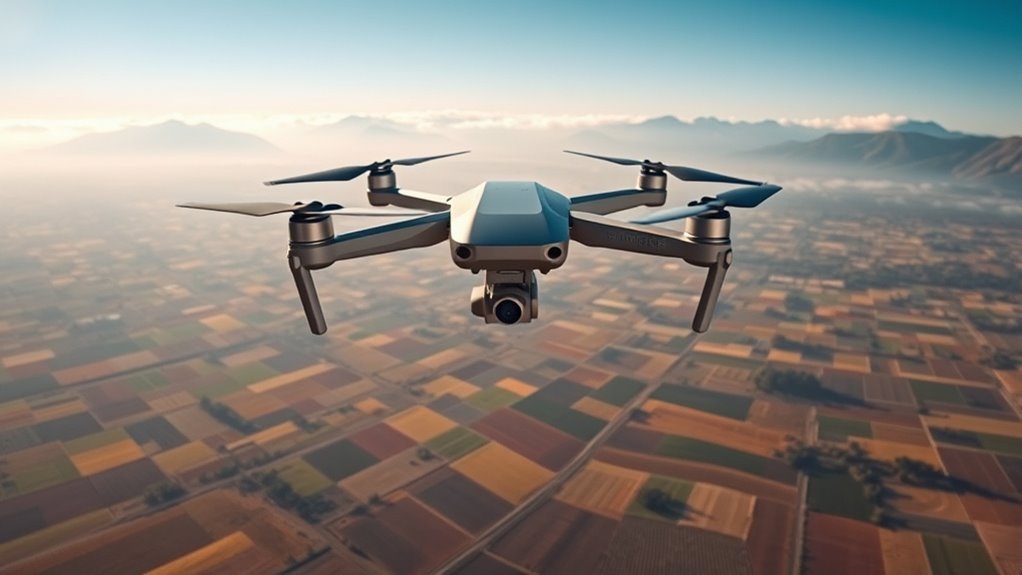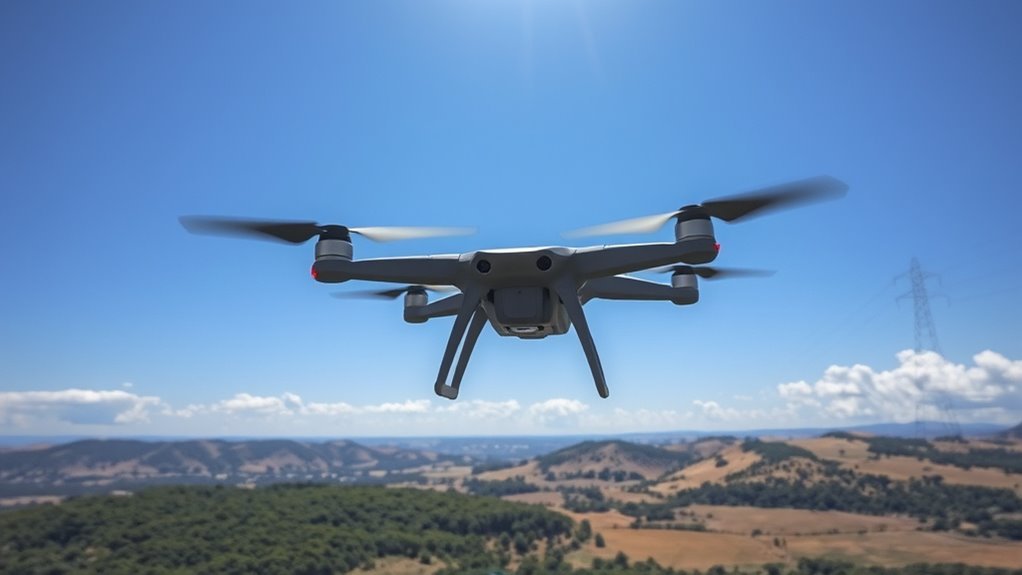Several factors affect how far you can fly a drone. Battery life and capacity are critical, as they determine flight time and distance. Environmental conditions, such as wind and temperature, can reduce efficiency. Weight and payload also play significant roles, impacting lift and range. Additionally, pilot experience and skill in maneuvering regulations influence flight capabilities. Understanding these elements helps optimize drone performance. If you’re curious about specific strategies to enhance your flight range, there’s more to explore.
Battery Life and Capacity

While you might be keen to maximize your drone’s flight distance, understanding battery life and capacity is crucial. Battery efficiency directly impacts how far you can fly. A higher capacity battery allows for longer flights, but it’s important to factor in weight and energy consumption. Each charging cycle affects battery longevity; frequent charging can diminish capacity over time. You’ll want to monitor how many cycles your battery undergoes to guarantee peak performance. Additionally, maintaining a balance between weight and battery size can enhance efficiency. By enhancing your drone’s battery life, you can achieve greater freedom in your flights, exploring further without the constant worry of returning before depleting your power. Battery capacity knowledge is key to revealing your drone’s full potential. For instance, the flight time metrics of different drone models can significantly influence your operational capabilities.
Drone Technology and Features

Battery life and capacity are just part of the equation when it comes to maximizing your drone’s flight distance. The technology and features of your drone play an equally important role. Consider these factors:
Maximizing your drone’s flight distance involves more than just battery life; technology and features are crucial too.
- Drone Sensors: Advanced sensors enhance navigation and obstacle avoidance, allowing longer, safer flights.
- Camera Quality: High-quality cameras may consume more power but can provide better images, influencing your flight strategy.
- Weight: The overall weight of your drone affects its lift capacity and battery usage—lighter drones often fly farther.
- Transmission Range: Stronger transmission systems extend your control range, enabling you to explore further without losing connection.
Additionally, modular technology in drones can significantly enhance your ability to customize flight plans and adapt to different environments. Understanding these elements helps you optimize your drone’s performance and truly enjoy the freedom of flight.
Environmental Conditions

When operating a drone, environmental conditions greatly influence its flight distance. Wind speed can create drag, reducing efficiency, while temperature affects battery performance and motor function. Additionally, visibility conditions may impact your ability to control the drone and assess its surroundings effectively.
Wind Speed Impact
Wind speed is a crucial factor that can greatly affect a drone’s flight distance. High wind speeds can lead to increased wind resistance, impacting drone stability and performance. When you’re flying, consider the following:
- Optimal Wind Conditions: Ideal wind speeds range between 0-10 mph for maximum stability.
- Increased Battery Drain: Strong winds require more power to maintain stability, reducing overall flight time.
- Control Difficulty: High winds can make it challenging to maneuver, risking loss of control.
- Altitude Considerations: Wind speeds can vary with altitude; make sure you’re aware of changes as you ascend.
Understanding these factors helps you make informed decisions, allowing you to push the boundaries of your drone’s capabilities while guaranteeing safe, efficient flight.
Temperature Effects
Environmental conditions, including temperature, play a significant role in a drone’s performance and flight distance. Temperature variations can lead to thermal effects that impact battery efficiency and motor performance. In colder conditions, battery capacity may decrease, resulting in reduced flight time and distance. Conversely, high temperatures can cause overheating, potentially leading to shutdowns or damage.
Managing these thermal effects is essential for maximizing your drone’s potential. You should monitor the operating environment and adjust flight plans accordingly. Understanding how temperature influences energy consumption enables you to maintain peak performance. By being aware of these factors, you can guarantee your drone achieves its maximum range and operates safely, granting you the freedom to explore the skies with confidence.
Visibility Conditions
Although many pilots may underestimate the impact, visibility conditions greatly influence a drone’s flight distance and overall safety. When you’re out flying, it’s essential to take into account these factors:
- Fog Effects: Reduced visibility can hinder your ability to navigate and maintain control.
- Night Flying: Darkness can obscure your drone’s path and make it difficult to judge distance.
- Weather Conditions: Rain or snow can create visual obstructions, impacting your flight range.
- Surrounding Terrain: Structures and natural obstacles can further limit visibility, affecting your flight planning.
Weight and Payload
When considering drone flight distance, understanding weight limitations is essential. Your drone’s maximum payload directly impacts its efficiency and range. By managing both the drone’s weight and the payload, you can optimize performance for longer flights. Additionally, aerodynamic design plays a crucial role in conserving energy, enabling you to achieve greater distances. Furthermore, advanced flight stability features, such as GPS-based hovering, can enhance overall control, allowing for more efficient energy use during extended flights.
Drone Weight Limitations
Understanding drone weight limitations is essential for optimizing flight distance. By managing weight effectively, you can enhance flight efficiency and control. Here are key factors to take into account:
- Drone Materials: Lighter materials, like carbon fiber and plastics, can reduce overall weight without compromising durability.
- Weight Distribution: Proper balance guarantees stability, affecting how well your drone maneuvers and maintains altitude.
- Maximum Takeoff Weight: Each drone has a specified weight limit; exceeding this can lead to decreased performance.
- Battery Weight: Heavier batteries may provide longer flight times but can also limit payload capacity, impacting distance.
Payload Impact on Distance
Payload considerably influences a drone’s flight distance, as the additional weight directly affects its power consumption and aerodynamic efficiency. The type of payload you choose plays a vital role; heavier or bulkier payloads require more energy, reducing flight time. Furthermore, proper payload distribution is essential; uneven weight can lead to instability, further impacting distance. If you’re carrying sensitive equipment, consider balancing the drone’s center of gravity to maximize performance. Understanding these factors allows you to strategize your missions effectively. By minimizing unnecessary weight and ensuring ideal payload distribution, you can enhance the drone’s efficiency, ultimately extending your flight range and achieving greater freedom in your aerial endeavors.
Signal Interference
Although signal interference can seem like a minor issue, it greatly impacts a drone’s flight distance and overall performance. Understanding the sources of interference is essential for maximizing your drone’s capabilities. Here are four key interference sources to take into account:
- Wi-Fi Networks: Overlapping frequencies can cause signal degradation.
- Power Lines: High-voltage lines create electromagnetic interference.
- Buildings and Structures: Physical barriers can obstruct signal pathways.
- Other Drones: Multiple drones operating nearby can lead to frequency congestion.
Flight Mode and Settings
While you might not realize it, the flight mode and settings of your drone play an important role in determining its flight distance and efficiency. Different flight modes, such as “Sport” or “GPS,” greatly impact how far you can fly. For instance, Sport mode may increase speed but can reduce stability and battery life. Conversely, GPS mode guarantees a stable hover, maximizing distance per battery charge. Additionally, proper battery management ensures that your drone can maintain optimal performance throughout its flight.
Furthermore, making precise settings adjustments—like altering altitude, speed, and flight path—can enhance your drone’s performance. It’s vital to find a balance that suits your operational needs while optimizing battery usage. By understanding and fine-tuning these elements, you can extend your drone’s range, allowing you to explore uncharted territories with confidence. A well-tuned navigation system, such as advanced GPS integration, is crucial for maximizing flight distance and ensuring accuracy during operations.
Local Regulations and Restrictions
Understanding local regulations and restrictions is crucial for maximizing your drone’s flight distance. Ignoring these can lead to fines or restricted access to airspace. Here are four key factors to reflect on:
- Local Laws: Familiarize yourself with the specific laws governing drone operations in your area, as they vary greatly.
- Airspace Restrictions: Be aware of controlled airspace zones, which may limit where you can fly your drone.
- No-Fly Zones: Identify areas like airports, military bases, and national parks where drone flights are prohibited.
- Altitude Limits: Know the maximum altitude permitted by local regulations to avoid legal issues and guarantee safe flying. Additionally, ensure that you have obtained the necessary permits from the U.S. Forest Service if planning to fly in national forests.
Pilot Experience and Skill
Pilot experience and skill greatly influence a drone’s flight distance, as seasoned operators can better navigate challenges that arise during flight. Effective pilot training equips you with essential techniques for maximizing range, ensuring you can respond swiftly to environmental factors like wind or battery efficiency. Regular skill evaluations allow you to identify areas for improvement, enhancing your decision-making under pressure. A proficient pilot can optimize flight paths and manage energy consumption, extending the drone’s operational limits. Understanding battery capacity and its impact on flight time is also essential for maximizing flight efficiency during your operations. Ultimately, the more adept you become at handling various scenarios, the further you can push your drone’s capabilities. By investing in your training and continually evaluating your skills, you’ll gain the freedom to explore greater distances with confidence and precision.
Maintenance and Condition of the Drone
To guarantee ideal flight distance, the maintenance and condition of your drone must be prioritized, as neglecting these factors can lead to decreased performance and range. Consistent drone upkeep is essential for enhancing your flight experience. Here are four key aspects to regard:
Prioritizing drone maintenance ensures optimal flight distance and performance, enhancing your overall flying experience.
- Battery Health: Regularly check and replace batteries based on their age and usage. Proper charging habits can significantly extend battery lifespan and performance.
- Propeller Condition: Inspect your propellers for signs of wear or damage; replace them if necessary.
- Firmware Updates: Keep your drone’s firmware updated to guarantee peak performance and features.
- Repair History: Document any repairs to monitor trends in issues; this can help predict future maintenance needs. Additionally, maintaining the battery capacity of your drone is crucial, as it directly influences the overall flight range.
Frequently Asked Questions
How Do Different Drone Brands Compare in Flight Distance?
When comparing drone brands, you’ll find that flight distance varies considerably based on drone specifications and brand reliability. Prioritizing models with robust communication systems typically guarantees greater distance and more freedom in your aerial adventures.
Can I Enhance My Drone’s Range With Modifications?
Just as Daedalus crafted wings for flight, you can enhance your drone’s range with modifications. Consider range extenders and antenna upgrades; these can greatly boost your drone’s capabilities, granting you newfound aerial freedom.
What Is the Ideal Altitude for Maximum Flight Distance?
The ideal altitude for maximum flight distance often balances altitude effects and flight efficiency. Generally, flying between 100 to 400 feet enhances range, minimizing obstacles and interference while optimizing battery performance and signal strength.
How Does Drone Color Impact Visibility and Distance?
Drone color greatly impacts visibility and distance. Bright colors enhance visibility against various backgrounds, allowing you to spot your drone from farther away, consequently improving your awareness and control during flight.
Are There Specific Apps to Track Drone Flight Distance?
Just like a compass guides a wanderer, flight tracking apps can steer you through distance measurement with precision. You’ll find options like DJI Go and Hover invaluable for monitoring your drone’s journey and ensuring freedom in flight.

